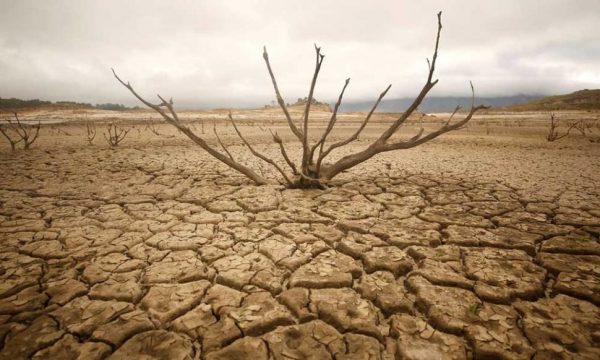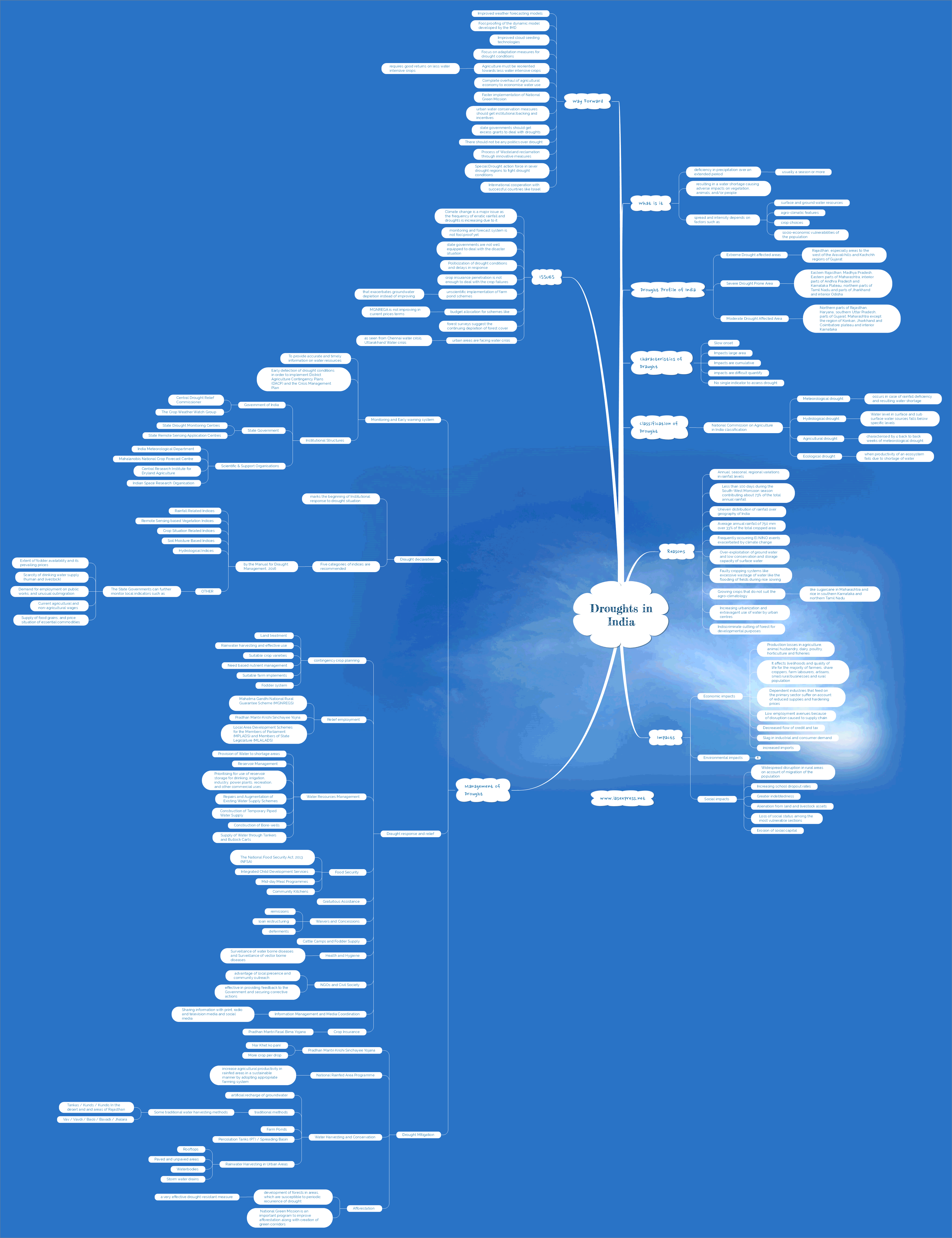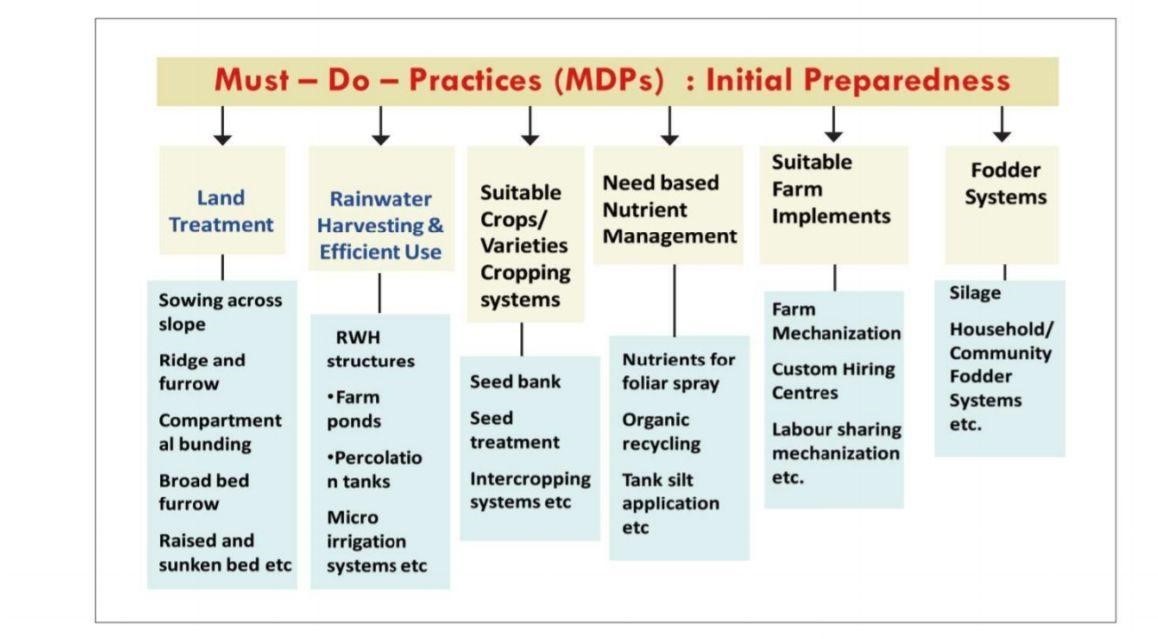[Disaster Series] Drought in India & its Management

Drought is a recurrent calamity that has grappled India over decades and centuries. An isolated subcontinent of India provides for unique climate conditions coupled with the variety in geography, the characteristic southwest monsoon has dealt with severe drought conditions in the past. The developmental needs, increasing population and climate change have been creating conditions of drought. The drought and its management is important governance and developmental issue.
This topic of “[Disaster Series] Drought in India & its Management” is important from the perspective of the UPSC IAS Examination, which falls under General Studies Portion.
What is Drought?
- Drought is deficient precipitation over a long period resulting in a water shortage causing adverse impacts on the human and larger ecological scenarios.
- Drought occurs from erratic rainfall and its distribution but the spread and intensity depend on factors such as surface and groundwater resources, agro-climatic features, crop choices, socio-economic vulnerabilities of the population, etc.
Drought Profile of India
Types of Drought Affected Areas:
- Extreme Drought affected areas
Rajasthan, especially areas to the west of the Aravali hills and Kachchh regions of Gujarat.
- Severe Drought Prone Areas
Eastern Rajasthan, Madhya Pradesh, Eastern parts of Maharashtra, interior parts of Andhra Pradesh and Karnataka Plateau, northern parts of Tamil Nadu and parts of Jharkhand and interior Odisha
- Moderate Drought Affected Area
Northern parts of Rajasthan, Haryana, southern Uttar Pradesh, parts of Gujarat, Maharashtra except the region of Konkan, Jharkhand and Coimbatore plateau and interior Karnataka
Characteristics of Drought
- Slow onset
- Impacts large area
- Impacts are cumulative
- As there are no structural damages, impacts are difficult to quantify
- No single indicator to assess drought
National Commission on Agriculture in India classified droughts into:
- Meteorological drought occurs in case of rainfall deficiency and resulting water shortage
- Hydrological drought– the Water level in surface and subsurface water sources falls below specific levels
- Agricultural drought is characterised by 4 back to back weeks of meteorological drought
- Ecological drought is when the productivity of an ecosystem fails due to shortage of water
What are the reasons for recurring droughts in India?
- Annual, seasonal, regional variations in rainfall levels.
- Less than 100 days during the South-West Monsoon season contributing about 73% of the total annual rainfall.
- Uneven distribution of rainfall over the geography of India.
- Average annual rainfall of 750 mm over 33% of the total cropped area.
- Frequently occurring El NINO events exacerbated by climate change.
- Over-exploitation of groundwater and low conservation and storage capacity of surface water.
- Faulty cropping systems like excessive wastage of water like the flooding of fields during rice sowing.
- Growing crops that do not suit the agro-climatology like sugarcane in Maharashtra and rice in southern Karnataka and northern Tamil Nadu. Due to this, India is a net water exporting country.
- Increasing urbanization and extravagant use of water by urban centres.
- Indiscriminate cutting of forest for developmental purposes.
What are the impacts of droughts?
Drought produces wide-ranging impacts across all the sectors of the economy. The impacts are felt by the economy much beyond the areas experiencing because agricultural production and water resources are integral to the production of goods and services.
The impacts of drought are
Economic impacts
- Production losses in agriculture, animal husbandry, dairy, poultry, horticulture, and fisheries.
- It affects livelihoods and quality of life for the majority of farmers, sharecroppers, farm labourers, artisans, small rural businesses and rural population.
- Dependent industries that feed on the primary sector suffer on account of reduced supplies and hardening prices.
- Low employment avenues because of disruption caused to the supply chain.
- Decreased flow of credit and tax.
- Slag in industrial and consumer demand.
- Increased imports.
Environmental impacts
- Low water levels in groundwater and surface reservoirs.
- Reduced flows in springs, streams, and rivers.
- Loss of forest cover.
- Wildlife migration and man-animal conflicts.
- The loss of wetlands may affect levels of salinity.
- Increased groundwater depletion and reduced recharge.
Social impacts
- Widespread disruption in rural areas on account of migration of the population.
- Increasing school dropout rates.
- Greater indebtedness.
- Alienation from land and livestock assets.
- Loss of social status among the most vulnerable sections.
- Erosion of social capital.
Management of drought
Drought management is an important governance mechanism that aims to predict, respond, mitigate and adapt to the drought conditions. Drought management goes through various stages. These are discussed further.
1. Monitoring and Early warning systems
-To provide accurate and timely information on water resources
-Early detection of drought conditions in order to implement District Agriculture Contingency Plans (DACP) and the Crisis Management Plan.
- Institutional Structures
Government of India
- Central Drought Relief Commissioner (CDRC)
- The Crop Weather Watch Group (CWWG)
State Government
- State Drought Monitoring Centres
- State Remote Sensing Application Centres (SRSACs)
- Scientific & Support Organisations
- India Meteorological Department (IMD)
- Mahalanobis National Crop Forecast Centre (MNCFC)
- Central Research Institute for Dryland Agriculture (CRIDA)
- Indian Space Research Organisation (ISRO)
- Drought declaration
‘Drought declaration’ marks the beginning of Institutional response to the drought situation.
Five categories of indices are recommended for developing monitoring for drought by the Manual for Drought Management, 2016. These are
- Rainfall Related Indices
- Remote Sensing based Vegetation Indices
- Crop Situation Related Indices
- Soil Moisture Based Indices
- Hydrological Indices
Other Factors
The State Governments can further monitor local indicators such as
- The extent of fodder availability and its prevailing prices
- Scarcity of drinking water supply (human and livestock)
- Demand for employment on public works, and unusual outmigration
- Current agricultural and non-agricultural wages
- Supply of food grains, and price situation of essential commodities
2. Drought response and relief
Implementation of drought relief and response measures are initiated following the declaration of drought.
- Contingency crop planning
- Relief employment
-
- Mahatma Gandhi National Rural Guarantee Scheme (MGNREGS)
- Pradhan Mantri Krishi Sinchayee Yojna
- Local Area Development Schemes for the Members of Parliament (MPLADS) and Members of State Legislature (MLALADS)
-
- Water Resources Management
-
- Provision of Water to shortage areas
- Reservoir Management
- Prioritising for use of reservoir storage for drinking, irrigation, industry, power plants, recreation, and other commercial uses.
- Repairs and Augmentation of Existing Water Supply Schemes
- Construction of Temporary Piped Water Supply
- Construction of Bore-wells
- Supply of Water through Tankers and Bullock Carts
-
- Food Security
-
- The National Food Security Act, 2013 (NFSA) which provides for coverage of up to 75% of the rural population and up to 50% of the urban population
- Integrated Child Development Services (ICDS)
- Mid-day Meal Programmes
- Community Kitchens
-
- Gratuitous Assistance
- Waivers and Concessions – remissions, waivers, deferments, loan restructuring, concessions, etc, taking into account the severity of the drought.
- Cattle Camps and Fodder Supply
- Health and Hygiene – Surveillance of water-borne diseases and Surveillance of vector-borne diseases
- Role of Non-Government Organizations (NGOs) and Civil Society Organizations (CSOs)
-
- NGOs and CSOs have the advantage of local presence and community outreach
- NGOs can also be very effective in providing feedback to the Government and securing corrective actions
-
- Information Management and Media Coordination – Sharing information with print, radio and television media and social media is an important aspect of drought management.
- Crop Insurance – Pradhan Mantri Fasal Bima Yojana (PMFBY) – PMFBY provides a comprehensive insurance cover against the failure of the crop due to various reasons
3. Drought mitigation
Current Drought Mitigation Programmes are
- Pradhan Mantri Krishi Sinchayee Yojana (PMKSY)
Motto of ‘Har Khet ko pani’ and improving water use efficiency with the motto of ‘More crop per drop’
- National Rainfed Area Programme
The objective of the programme is to increase agricultural productivity in rainfed areas in a sustainable manner by adopting an appropriate farming system
- Water Harvesting and Conservation
Water harvesting and conservation refer to processes and structures of rainfall and runoff collection from large catchments area and channelling them for human consumption
The methods of water conservation are (i) artificial recharge of groundwater, and (ii) traditional methods.
Farm Ponds
important component and useful in storing water for irrigation. They also retard sediment and flood flows to the downstream river system.
Percolation Tanks (PT) / Spreading Basin
One of the effective measures by which groundwater recharge can be achieved is by the construction and use of percolation tanks.
Some traditional water harvesting methods
- Tankas / Kunds / Kundis In the desert and arid areas of Rajasthan people build unique underground structures of various shapes and sizes to collect rainwater for drinking purposes.
- Vav / Vavdi / Baoli / Bavadi / Jhalara These are traditional step-wells in Rajasthan and northern India. These ancient water harvesting systems collect subterranean seepage of a talab or a lake located upstream
Rainwater Harvesting in Urban Areas
- Rooftops: the catchment area is effectively available free of charge and can provide enough supply.
- Paved and unpaved areas: Landscapes, open fields, parks, stormwater drains, roads and pavements, and other open areas
- Waterbodies: The contribution of lakes, tanks and ponds to store rainwater is immense.
- Stormwater drains: Most of the residential colonies have a proper network of stormwater drains.
Afforestation
- It is well-known that the development of forests in areas, which are susceptible to periodic recurrence of drought, is indeed a very effective drought-resistant measure.
- The National Green Mission is an important program to improve afforestation along with the creation of green corridors.
What are the issues in Drought management?
- Climate change is a major issue as the frequency of erratic rainfall and droughts is increasing due to it.
- The monitoring and forecast system is not foolproof yet. More research and development is needed.
- The state governments are not well equipped to deal with the disaster situation of drought.
- The politicization of drought conditions and delays in response.
- The crop insurance penetration is not enough to deal with the crop failures
- The unscientific implementation of farm pond schemes that exacerbates groundwater depletion instead of improving.
- The budget allocation for schemes like MGNREGA is not improving in current price terms.
- The forest surveys suggest the continuing depletion of forest cover.
- The urban areas are facing a water crisis as seen from the Chennai water crisis, Uttarakhand Water crisis.
Way forward
- Improved weather forecasting models.
- Fool proofing of the dynamic model developed by the IMD.
- Improved cloud seeding technologies.
- Focus on adaptation measures for drought conditions.
- Agriculture must be reoriented towards less water-intensive crops. That requires good returns on less water-intensive crops.
- A complete overhaul of the agricultural economy to economise water use.
- Faster implementation of National Green Mission.
- Urban water conservation measures should get institutional backing and incentives.
- The state governments should get excess grants to deal with droughts
- There should not be any politics over drought.
- Process of Wasteland reclamation through innovative measures.
- Special Drought action force in severe drought regions to fight drought conditions.
- International cooperation with successful countries like Israel for water conservation measures.
Practice Question for Mains
The record in Successive drought years is a proof of India’s inadequate focus on drought management. Critically examine (250 words)




Little more elaboration would be more better